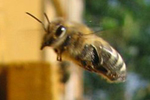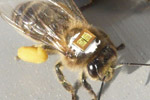
European common frog (Rana temporaria). Photo by: Richard Bartz.
Commonly used agrochemicals (insecticides, fungicides and herbicides) kill frogs outright when sprayed on fields even when used at recommended dosages, according to new research in Scientific Reports. Testing seven chemicals on European common frogs (Rana temporaria), the scientists found that all of them were potentially lethal to amphibians. In fact, two fungicides—Headline and Captain Omya—wiped out the entire population of frogs at the recommended dosage. The study warns that agricultural chemicals could be having a large-scale and largely unrecorded impact on the world’s vanishing amphibians.
While there has been significant research on how agrochemical impacts tadpoles in water, scientists have not studied how amphibians react to direct spraying once they’ve moved from their tadpole stage onto land.
“Terrestrial exposure results in more dramatic effects [than aquatic exposure]—direct mortality,” lead author Carsten A. Brühl with the University Koblenz-Landau told mongabay.com. “This is unexpected, especially from a fungicide such as Headline.”
Shockingly, Headline killed all the frogs in just one hour’s time at its recommended dosage. Mortality rates ranged from a low of 20 percent to 100 percent for the seven chemicals.
“The observation of acute mortality in a vertebrate group caused by commercially available pesticides at recommended field rates is astonishing,” Brühl and his team write in the paper, “since 50 years after the publication of Rachel Carson’s Silent Spring one would have thought that the development of refined risk assessment procedures and our growing understanding of environmentally effective chemicals would make such effects virtually impossible.”
However a representative with Headline manufacturer BASF told the Guardian that the study only represented “laboratory ‘worst-case’ conditions.”
“Under normal agricultural conditions amphibians are not exposed to such pesticide concentrations,” they said. “According to our knowledge, no significant impact on amphibian populations has been reported despite the widespread and global use of the fungicide pyraclostrobin.”
But Brühl says there is good evidence “that amphibians are present in fields during [agrochemical] applications—sometimes more than 50 percent of the breeding population of certain species.”
He notes that the agrochemical industry often relies on “interception” rates for their research, i.e. the amount of pesticide that stays on the plants and doesn’t reach the ground. But Brühl’s study found that 3 of the 7 chemicals were still lethal to frogs even when the recommended dosage was cut by 90 percent. In addition, many agricultural fields are sprayed multiple times with more than one chemical.
“Maybe BASF is willing to provide interception values for the crops when they apply Headline—it would then be very easy to identify risk,” Brühl notes.
Brühl says he would not call any of the chemicals in the study “safe” for amphibians. Still he notes that more research must be done to understand how agrochemicals impact frogs directly in the fields, as opposed to controlled experiments.
“This needs to be done for every crop and dependent on the situation,” he says. “It is now more important to understand the mechanisms behind the effects.”
Amphibians are considered among the most imperiled groups on Earth: one third of the world’s amphibians are currently considered threatened by extinction. For decades they have faced large-scale habitat loss, pollution, and a virulent disease known as the chytrid fungus. Scientists believe 130 amphibians have gone extinct in the last 30 years alone.
Currently, European regulators do not require that agrochemical companies test the impacts of their products on amphibians. Brühl said that the chemicals are generally considered safe for amphibians if they are found to be safe for birds and mammals, but “due to the difference in skin properties [of amphibians] they are not safe when on land.” Other animals with permeable skin, such as snails and slugs, as well as reptile eggs, may also be at risk, according to Brühl.
“If you want to conserve amphibians on your fields—since they feed on pest insects and therefore provide free pest control—avoid spraying during migration times to or from ponds in the agricultural landscape,” he says. “Think about a buffer strip around ponds.”
Brühl’s study is not the only recent research linking agrochemicals to wildlife declines. Last year a flood of high-profile research found that the global bee decline is very likely linked, at least in part, to the rising use of neonicotinoid pesticides. Several studies found that while these pesticides don’t kill bees instantly, they impact individual behavior, such as a bee’s ability to navigate and forage. One study found that after several months of exposure, hives simply collapsed. The research convinced the European Food Safety Authority to label neonicotinoid pesticides as an “unacceptable” danger for bees.

Mortality of juvenile European common frogs (Rana temporaria) after seven days following an overspray exposure for seven pesticides at 0.1×, 1× and 10× the label rate (formulation name, active substance and class are given). Graph: Brühl et al. Click to enlarge.
CITATION: Brühl, Carsten A.; Schmidt, Thomas; Pieper, Silvia; Alscher, Annika. Terrestrial pesticide exposure of amphibians: An underestimated cause of global decline? Scientific Reports. 2013. http://dx.doi.org/10.1038/srep01135
Related articles
EPA considers ban on herbicide that triggers sex reversal in frogs
(06/08/2012) The Environmental Protection Agency (EPA) will weigh a ban on Atrazine, a widely used herbicide linked to sex reversal and other reproductive problems in amphibians and fish. The chemical, which is manufactured by Syngenta, has been banned in the European Union since 2004 but some 80 million pounds Atrazine are applied to corn, sugarcane, sorghum and rice in the United States each year.
New study adds to evidence that common pesticides decimating bee colonies

(10/24/2012) The evidence that common pesticides may be partly to blame for a decline in bees keeps piling up. Several recent studies have shown that pesticides known as “neonicotinoid” may cause various long-term impacts on bee colonies, including fewer queens, foraging bees losing their way, and in some cases total hive collapse. The studies have been so convincing that recently France banned the use of neonicotinoid pesticides. Now a new study finds further evidence of harm caused by pesticides, including that bees who are exposed to more than one chemical, i.e. neonicotinoid and pyrethroid, were the most vulnerable.
Mercury hurts birds and people: what we can learn from studying our feathered friends

(01/07/2013) Birds aren’t that different from people. We learn from our parents, just like zebra finches learn songs from their fathers. We are active and noisy during the day, like birds, and we can also be territorial. Also like birds, we try to attract mates through colorful displays and beautiful songs. Birds are sensitive to pollution in their environment just like we are: harmful elements such as mercury wreak similar havoc on human and bird biology alike. Because our species share so many attributes, studying birds illustrates the connections between them and us.
After damning research, France proposes banning pesticide linked to bee collapse
(06/04/2012) Following research linking neonicotinoid pesticides to the decline in bee populations, France has announced it plans to ban Cruiser OSR, an insecticide produced by Sygenta. Recent studies, including one in France, have shown that neonicotinoid pesticides likely hurt bees’ ability to navigate, potentially devastating hives. France has said it will give Sygenta two weeks to prove the pesticide is not linked to the bee decline, known as Colony Collapse Disorder (CCD).
Researchers recreate bee collapse with pesticide-laced corn syrup

(04/05/2012) Scientists with the Harvard School of Public Health (HSPH) have re-created the mysterious Colony Collapse Disorder in several honeybee hives simply by giving them small doses of a popular pesticide, imidacloprid. Bee populations have been dying mysteriously throughout North America and Europe since 2006, but the cause behind the decline, known as Colony Collapse Disorder, has eluded scientists. However, coming on the heels of two studies published last week in Science that linked bee declines to neonicotinoid pesticides, of which imidacloprid is one, the new study adds more evidence that the major player behind Colony Collapse Disorder is not disease, or mites, but pesticides that began to be widely used in the 1990s.
Smoking gun for bee collapse? popular pesticides

(03/29/2012) Commonly used pesticides may be a primary driver of the collapsing bee populations, finds two new studies in Science. The studies, one focused on honeybees and the other on bumblebees, found that even small doses of these pesticides, which target insect’s central nervous system, impact bee behavior and, ultimately, their survival. The studies may have far-reaching repercussions for the regulation of agricultural chemicals, known as neonicotinoid insecticides, that have been in use since the 1990s.